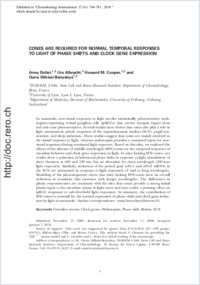Cones are required for normal temporal responses to light of phase shifts and clock gene expression
- Dollet, Anna INSERM, U846, Stem Cell and Brain Research Institute, Department of Chronobiology, Bron, France - University of Lyon, Lyon I, France
- Albrecht, Urs Department of Medicine, Division of Biochemistry, University of Fribourg, Switzerland
- Cooper, Howard M. INSERM, U846, Stem Cell and Brain Research Institute, Department of Chronobiology, Bron, France - University of Lyon, Lyon I, France
- Dkhissi-Benyahya, Ouria INSERM, U846, Stem Cell and Brain Research Institute, Department of Chronobiology, Bron, France - University of Lyon, Lyon I, France
-
2010
Published in:
- Chronobiology International. - 2010, vol. 27, no. 4, p. 768-781
English
In mammals, non-visual responses to light involve intrinsically photosensitive melanopsin-expressing retinal ganglion cells (ipRGCs) that receive synaptic inputs from rod and cone photoreceptors. Several studies have shown that cones also play a role in light entrainment, photic responses of the suprachiasmatic nucleus (SCN), pupil constriction, and sleep induction. These studies suggest that cones are mainly involved in the initial response to light, whereas melanopsin provides a sustained input for non-visual responses during continued light exposure. Based on this idea, we explored the effects of the absence of middle-wavelength (MW)-cones on the temporal responses of circadian behavior and clock gene expression in light. In mice lacking MW-cones, our results show a reduction in behavioral phase shifts in response to light stimulations of short duration at 480 and 530***Missing image substitution***nm, but no alteration for short-wavelength (360-nm) light exposures. Similarly, induction of the period gene mPer1 and mPer2 mRNAs in the SCN are attenuated in response to light exposures of mid to long wavelengths. Modeling of the photoresponses shows that mice lacking MW-cones have an overall reduction in sensitivity that increases with longer wavelengths. The differences in photic responsiveness are consistent with the idea that cones provide a strong initial phasic input to the circadian system at light-onset and may confer a priming effect on ipRGC responses to sub-threshold light exposures. In summary, the contribution of MW-cones is essential for the normal expression of phase shifts and clock gene induction by light in mammals.
- Faculty
- Faculté des sciences et de médecine
- Department
- Département de Biologie
- Language
-
- English
- Classification
- Biological sciences
- License
-
License undefined
- Identifiers
-
- RERO DOC 20240
- DOI 10.3109/07420521003695704
- Persistent URL
- https://folia.unifr.ch/unifr/documents/301751
Statistics
Document views: 93
File downloads:
- pdf: 209
